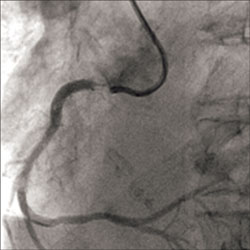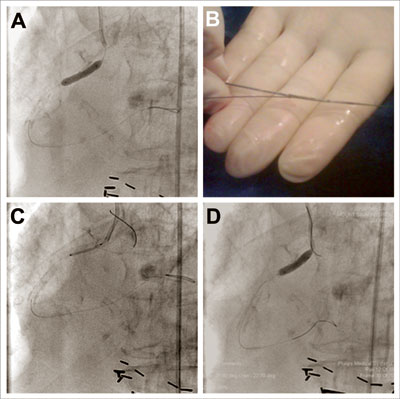The Szabo Technique in a Patient with Ostial RCA In-Stent Restenosis
A 75-year-old female presented with a 2-month history of worsening exertional angina with occasional rest episodes, and had a prior history of PCI to the ostial and proximal 15 months previously with a drug-eluting stent (Taxus, Boston Scientific). The patient also suffered from controlled hypertension and chronic renal failure requiring hemodialysis.
|
Images: Samin K. Sharma, MD; reprinted with permission. |
Coronary angiography at an outside hospital revealed proximal/ostial right coronary artery (RCA) in-stent restenosis (ISR) resulting in subtotal occlusion (Figure 1), with mild and non-obstructive disease in left anterior descending and circumflex arteries. An attempt to perform PCI on the offending lesion was made at an outside hospital, which was unsuccessful due to significant stent protrusion into the aorta. The patient was referred to our hospital for further management.
PCI was performed via a right common femoral artery approach using a 45-cm (“long”) sheath to ensure maximal guide catheter support. As there was no possibility of “engaging” the culprit vessel and because the RCA ostium was high and posteriorly placed, an AL-0.75 guide catheter was used. In the Szabo technique, the possibility exists of friction during stent passage within the guiding catheter, therefore a 7F system was used. A 1.5-mm × 150-cm microcatheter (FineCross, Terumo) with a 0.014-inch × 180-cm guidewire (Fielder, Abbott) was used to cross the lesion. The microcatheter was removed by trapping the wire with a 2.5-mm × 20-mm compliant balloon (Apex, Boston Scientific) inflated within the guide to 8 atm. The lesion was pre-dilated using the same 2.5-mm × 20-mm balloon, followed by a 4-mm × 20-mm balloon (Voyager NC, Abbott) to 16 atm (Figure 2A).
|
|
A 4-mm × 18-mm stent (Xience V, Abbott) was loaded onto the guidewire in the usual way, but before insertion into the guide catheter, the proximal (stiff) end of a second guidewire (Runthrough, Terumo) was threaded through the most proximal stent strut. To facilitate this process, the stent balloon was slowly inflated to 4 atm while squeezing the distal end of the stent with firm manual pressure. When the proximal end of the stent was seen to flare, the balloon was immediately deflated and the anchor wire easily threaded through the last stent strut (Figure 2B). The flared end of the stent was then manually crimped back onto the balloon. The stent, loaded on two wires as described above, was then advanced into position in preparation for deployment, with the distal end of the Runthrough (anchor) wire permitted to prolapse into the aortic root, keeping the stent from passing inside the original Taxus stent.
Consistent with the position of the original Taxus stent, in its final position prior to deployment and with the anchor wire in place, the Xience V stent was noted to protrude beyond the true coronary ostium and into the aorta (Figure 2C). The stent was deployed at low pressure (6 atm), and the anchor wire retracted (Figure 2D). The stent was then fully deployed at 12 atm. Finally, the stent balloon was partially withdrawn and ostial flaring performed at 20 atm. The final result was satisfactory with TIMI III flow (Figure 3).
Discussion
Ostial disease is traditionally defined as a lesion arising within 3 mm of the vessel origin, and may be classified by location as aorto-ostial, non aorto-ostial or branch-ostial. Numerous techniques have been described for achieving accurate stent placement for these lesions, and new approaches continue to emerge. However, the recently described Szabo technique for accurate ostial stent placement is proving to be a simple, precise and cost-effective method that is rapidly gaining in popularity.
Importantly and unique to this case, unlike the traditional “ostial” indication for the Szabo technique, the desired position for stent deployment in this patient was not at a true coronary ostium, but just proximal to a previously placed Taxus stent and protruding approximately 1 mm to 2 mm back into the aorta from the anatomical RCA ostium. In particular, given that the restenotic lesion extended to the very proximal edge of the Taxus stent, we were concerned that it was critical to achieve full coverage of this lesion.
|
|
The Szabo technique offered several advantages for this case: because the anchor wire was threaded through the most proximal stent strut, the technique permitted the Xience V stent to be positioned precisely one strut proximal to the restenotic Taxus stent; stent positioning was not dependent on angiography; the anchor wire gave added stability to the system and minimized movement at the time of stent deployment; and, by applying very gentle forward pressure on the stent during deployment, the possibility that the stent may be deployed too far back in the aorta was essentially eliminated.
Although a very satisfactory result was achieved, we highlight that this technique is not without potential pitfalls, including risk of damage to the stent balloon from the anchor wire, stent distortion preventing advancement within the guide catheter, risk of stripping the stent if retraction into guide is required, and risk of anchor wire entrapment. However, the use of a 7F system and removal of the anchor wire after initial low pressure stent deployment will minimize the likelihood of these events.
Conclusion
In conclusion, we suggest that in addition to true ostial lesions, the Szabo technique should be considered when repeat intervention is required on a restenotic stent that protrudes into the aorta.
References:
Fischell TA. Catheter Cardiovasc Interv. 2008;71:353-357.
Iakovou I. J Am Coll Cardiol. 2004;44:967-971.
Kern MJ. Catheter Cardiovasc Interv. 2006;68:901-906.
Kovacic JC. Catheter Cardiovasc Interv. 2011; [published online ahead of print Dec. 8].
Szabo S. Am J Cardiol. 2005;96:212H.
For more information:
Amit Sharma, MD, is an interventional fellow at Mount Sinai School of Medicine, New York; Jason C. Kovacic, MD, PhD, is an assistant professor of cardiology at Mount Sinai School of Medicine; and Samin K. Sharma, MD, is professor of medicine and co-director at the Cardiovascular Institute, Mount Sinai Medical Center.
Disclosure:
Drs. Kovacic, A. Sharma and S.K. Sharma report no relevant financial disclosures.



